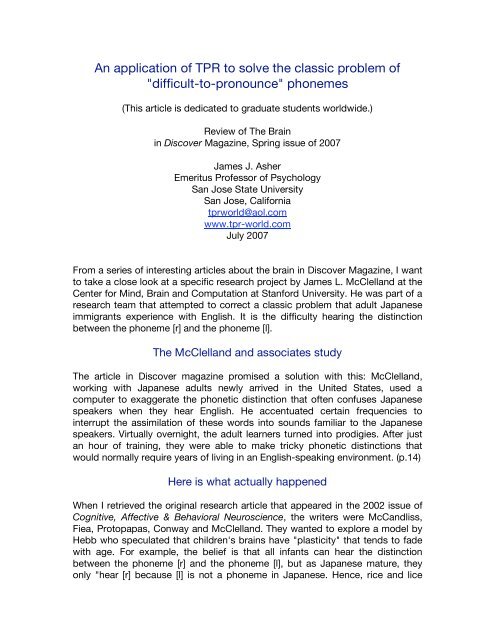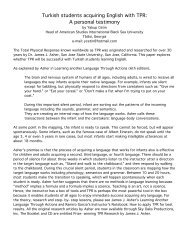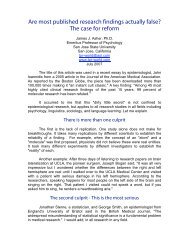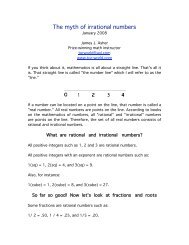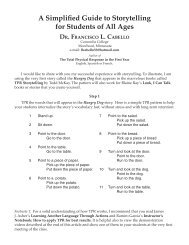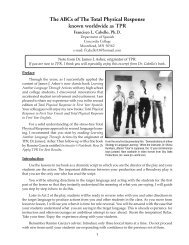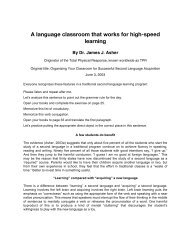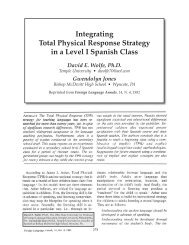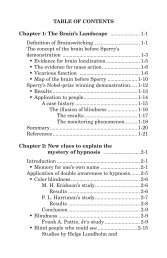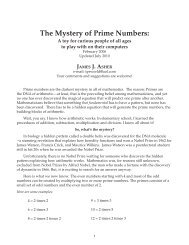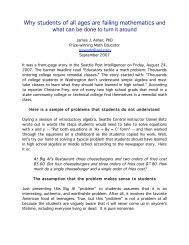An application of TPR to solve the classic problem of ... - TPR World
An application of TPR to solve the classic problem of ... - TPR World
An application of TPR to solve the classic problem of ... - TPR World
You also want an ePaper? Increase the reach of your titles
YUMPU automatically turns print PDFs into web optimized ePapers that Google loves.
<strong>An</strong> <strong>application</strong> <strong>of</strong> <strong>TPR</strong> <strong>to</strong> <strong>solve</strong> <strong>the</strong> <strong>classic</strong> <strong>problem</strong> <strong>of</strong><br />
"difficult-<strong>to</strong>-pronounce" phonemes<br />
(This article is dedicated <strong>to</strong> graduate students worldwide.)<br />
Review <strong>of</strong> The Brain<br />
in Discover Magazine, Spring issue <strong>of</strong> 2007<br />
James J. Asher<br />
Emeritus Pr<strong>of</strong>essor <strong>of</strong> Psychology<br />
San Jose State University<br />
San Jose, California<br />
tprworld@aol.com<br />
www.tpr-world.com<br />
July 2007<br />
From a series <strong>of</strong> interesting articles about <strong>the</strong> brain in Discover Magazine, I want<br />
<strong>to</strong> take a close look at a specific research project by James L. McClelland at <strong>the</strong><br />
Center for Mind, Brain and Computation at Stanford University. He was part <strong>of</strong> a<br />
research team that attempted <strong>to</strong> correct a <strong>classic</strong> <strong>problem</strong> that adult Japanese<br />
immigrants experience with English. It is <strong>the</strong> difficulty hearing <strong>the</strong> distinction<br />
between <strong>the</strong> phoneme [r] and <strong>the</strong> phoneme [l].<br />
The McClelland and associates study<br />
The article in Discover magazine promised a solution with this: McClelland,<br />
working with Japanese adults newly arrived in <strong>the</strong> United States, used a<br />
computer <strong>to</strong> exaggerate <strong>the</strong> phonetic distinction that <strong>of</strong>ten confuses Japanese<br />
speakers when <strong>the</strong>y hear English. He accentuated certain frequencies <strong>to</strong><br />
interrupt <strong>the</strong> assimilation <strong>of</strong> <strong>the</strong>se words in<strong>to</strong> sounds familiar <strong>to</strong> <strong>the</strong> Japanese<br />
speakers. Virtually overnight, <strong>the</strong> adult learners turned in<strong>to</strong> prodigies. After just<br />
an hour <strong>of</strong> training, <strong>the</strong>y were able <strong>to</strong> make tricky phonetic distinctions that<br />
would normally require years <strong>of</strong> living in an English-speaking environment. (p.14)<br />
Here is what actually happened<br />
When I retrieved <strong>the</strong> original research article that appeared in <strong>the</strong> 2002 issue <strong>of</strong><br />
Cognitive, Affective & Behavioral Neuroscience, <strong>the</strong> writers were McCandliss,<br />
Fiea, Pro<strong>to</strong>papas, Conway and McClelland. They wanted <strong>to</strong> explore a model by<br />
Hebb who speculated that children's brains have "plasticity" that tends <strong>to</strong> fade<br />
with age. For example, <strong>the</strong> belief is that all infants can hear <strong>the</strong> distinction<br />
between <strong>the</strong> phoneme [r] and <strong>the</strong> phoneme [l], but as Japanese mature, <strong>the</strong>y<br />
only "hear [r] because [l] is not a phoneme in Japanese. Hence, rice and lice
sound like rice and rice, rock and lock sound like rock and rock and road and<br />
load sound like road and road. Linguists describe this as being "functionally<br />
deaf" for phonemes that are absent from our native language. The linguists, in<br />
my opinion, are quite correct, at least for <strong>the</strong> left hemisphere <strong>of</strong> <strong>the</strong> brain.<br />
The <strong>problem</strong> with <strong>the</strong> research<br />
The <strong>problem</strong> with this research project is that <strong>the</strong> researchers were "functionally<br />
blind" <strong>to</strong> a critical filter that determines <strong>the</strong> outcome <strong>of</strong> any psychological or<br />
linguistic research study. That filter is whe<strong>the</strong>r <strong>the</strong> study is playing <strong>to</strong> <strong>the</strong> right or<br />
<strong>the</strong> left hemisphere <strong>of</strong> <strong>the</strong> brain. In this case, it was playing <strong>to</strong> <strong>the</strong> left side <strong>of</strong> <strong>the</strong><br />
brain because subjects sat in front <strong>of</strong> a computer screen, listened <strong>to</strong> a minimal<br />
pair such as rock and lock and pressed a key for "same" or "different." That was<br />
one test. <strong>An</strong>o<strong>the</strong>r test was <strong>to</strong> listen <strong>to</strong> each word and press a key for [r] if <strong>the</strong><br />
word started with an [r] or [l] if <strong>the</strong> word started with an [l].<br />
The results<br />
Subjects experienced more than 100 trials with a single minimal pair <strong>of</strong> "rock<br />
lock" under various conditions. To explore transfer-<strong>of</strong>-learning <strong>the</strong>y used a<br />
different pair, which was "road load". The <strong>to</strong>tal learning time was about one<br />
hour. The results showed some gain when a correct identification was rewarded<br />
with green check marks.<br />
My interpretation<br />
A hundred trials is an enormous amount <strong>of</strong> work for a small return <strong>of</strong><br />
discriminating a single minimal pair. In my opinion, <strong>the</strong> reason for this is: The<br />
study was playing <strong>to</strong> half <strong>of</strong> <strong>the</strong> brain and in this case <strong>the</strong> wrong half. The left<br />
side is <strong>the</strong> talking side <strong>of</strong> <strong>the</strong> brain and because it is hypercritical, it tends <strong>to</strong><br />
resist change. <strong>An</strong>ything different from <strong>the</strong> familiar is perceived as change. For<br />
example, <strong>the</strong> incumbent for any political <strong>of</strong>fice in <strong>the</strong> USA has a 95 percent<br />
change <strong>of</strong> being re-elected. We prefer <strong>the</strong> familiar <strong>to</strong> <strong>the</strong> unfamiliar, unless <strong>the</strong><br />
familiar has been marred, for instance with a scandal.<br />
The left brain evaluates everything coming in <strong>to</strong> be sure it is safe. The best way<br />
<strong>to</strong> be safe and secure is <strong>to</strong> continue doing what we have always done. Novelty<br />
is a <strong>problem</strong> for <strong>the</strong> left brain. <strong>An</strong>ything different could be dangerous. Why take<br />
a chance? Stick with <strong>the</strong> "tried and <strong>the</strong> true." A <strong>classic</strong> example <strong>of</strong> <strong>the</strong> left brain<br />
is a sign above <strong>the</strong> light switch in <strong>the</strong> turn-<strong>of</strong>-<strong>the</strong> century wing <strong>of</strong> <strong>the</strong> old<br />
Coronado Hotel in San Diego. The sign reads: "This switch turns on <strong>the</strong> electric<br />
lights. They will not harm you." It <strong>to</strong>ok many years before people trusted that<br />
electric lights were harmless.
<strong>An</strong> alternate way <strong>to</strong> <strong>solve</strong> <strong>the</strong> <strong>problem</strong><br />
Next, I want <strong>to</strong> suggest an alternate approach that I believe is more powerful<br />
than <strong>the</strong> passive sit-in-front-<strong>of</strong>-a-computer screen, listening <strong>to</strong> minimal pairs<br />
such as "rake" and "lake" or "rocket" and "locket" and typing in a response on<br />
<strong>the</strong> keyboard. This is a brainswitch from <strong>the</strong> critical talking left brain <strong>to</strong> <strong>the</strong> mute,<br />
but non-evaluative right brain.<br />
I want <strong>to</strong> urge candidates for a master's or doc<strong>to</strong>ral degree <strong>to</strong> seriously consider<br />
this project for <strong>the</strong>ir <strong>the</strong>sis, and I guarantee that if <strong>the</strong> project is completed with<br />
meticulous attention <strong>to</strong> detail, it will be welcomed and published by The Modern<br />
Language Journal, The International Review <strong>of</strong> Applied Linguistics, Foreign<br />
Language <strong>An</strong>nals, Philologia, or <strong>the</strong> Journal <strong>of</strong> Applied Psychology.<br />
Apply a brainswitch with James Asher's<br />
Total Physical Response, known worldwide as <strong>TPR</strong><br />
Plan A is <strong>to</strong> replicate <strong>the</strong> study by McClelland and associates except instead <strong>of</strong><br />
sitting in front <strong>of</strong> a computer screen, ga<strong>the</strong>r <strong>the</strong> subjects in a classroom and<br />
invite two volunteer Japanese speakers <strong>to</strong> sit on ei<strong>the</strong>r side <strong>of</strong> you at <strong>the</strong> front <strong>of</strong><br />
<strong>the</strong> room. Here is <strong>the</strong> pattern:<br />
You say: "Stand" (and gesture <strong>to</strong> <strong>the</strong> people on ei<strong>the</strong>r side <strong>of</strong> you <strong>to</strong> stand.<br />
Note: if <strong>the</strong>y try <strong>to</strong> repeat your direction, signal silence by placing your finger on<br />
your lips.)<br />
Next: "Sit" (you sit and gesture your subjects <strong>to</strong> sit).<br />
Again: "Stand."<br />
Then: "Sit."<br />
Continue with: "Stand" (you remain seated and gesture <strong>the</strong> individuals <strong>to</strong> stand).<br />
Then you say: "Sit" (and gesture for <strong>the</strong>m <strong>to</strong> sit).<br />
Next you say: "Stand" (and stand up with <strong>the</strong>m).<br />
Then: "Walk" (and you walk with <strong>the</strong>m).<br />
Now: "S<strong>to</strong>p" (and you s<strong>to</strong>p with <strong>the</strong>m).<br />
Next: "Walk" (but you remain where you are and let <strong>the</strong>m walk by <strong>the</strong>mselves).
You say: "S<strong>to</strong>p."<br />
Now you join <strong>the</strong>m and say, "Turn" while you turn with <strong>the</strong>m and "Turn" again<br />
and once more "Turn."<br />
While you remain where you are, say, "Walk. S<strong>to</strong>p. Walk. S<strong>to</strong>p. Turn. Sit."<br />
Now join <strong>the</strong>m at <strong>the</strong>ir seats and invite one <strong>of</strong> <strong>the</strong> individuals <strong>to</strong> perform alone.<br />
For example, here is what you say <strong>to</strong> Emi:<br />
To Emi: "Stand. Walk. S<strong>to</strong>p. Walk. S<strong>to</strong>p. Turn. Turn. Turn. Walk. S<strong>to</strong>p. Sit."<br />
To Shirou: (Vary <strong>the</strong> sequence slightly with:) "Stand. Sit. Stand. Walk. S<strong>to</strong>p.<br />
Turn. Walk. S<strong>to</strong>p. Turn. Sit." (Continually encourage <strong>the</strong> onlookers <strong>to</strong> applaud.)<br />
To observe how simple and graceful this can be, please see my personal<br />
demonstration in <strong>the</strong> DVD from <strong>the</strong> Nor<strong>the</strong>astern Conference <strong>of</strong> FL/ESL<br />
Instruc<strong>to</strong>rs at www.tpr-world.com.<br />
Now act with <strong>the</strong>m <strong>to</strong>: "Stand. Point <strong>to</strong> <strong>the</strong> chair. Point <strong>to</strong> <strong>the</strong> table. Point <strong>to</strong> <strong>the</strong><br />
door."<br />
Now individuals act alone.<br />
To Shirou: "Point <strong>to</strong> <strong>the</strong> chair. Walk <strong>to</strong> <strong>the</strong> chair."<br />
To Emi: "Point <strong>to</strong> <strong>the</strong> table. Walk <strong>to</strong> <strong>the</strong> table."<br />
To Shirou: "Point <strong>to</strong> <strong>the</strong> door. Walk <strong>to</strong> <strong>the</strong> door. Touch <strong>the</strong> door." (You act with<br />
him because he has never heard "<strong>to</strong>uch" before.)<br />
To Emi: "Walk <strong>to</strong> <strong>the</strong> table. Touch <strong>the</strong> table."<br />
To Shirou: "Walk <strong>to</strong> <strong>the</strong> chair. Touch <strong>the</strong> chair. Sit on <strong>the</strong> chair."<br />
To Emi: "Walk <strong>to</strong> <strong>the</strong> table. Touch <strong>the</strong> table. Sit on <strong>the</strong> table."<br />
Next, you demonstrate with <strong>the</strong> subjects. "Stand. Point <strong>to</strong> <strong>the</strong> rocket. Point <strong>to</strong><br />
<strong>the</strong> locket."<br />
Now <strong>the</strong> individuals act alone. For example, here is what you say <strong>to</strong> Emi:<br />
To Emi: "Walk <strong>to</strong> <strong>the</strong> rocket. Pick up <strong>the</strong> rocket. Point <strong>to</strong> <strong>the</strong> locket. Pick up <strong>the</strong><br />
locket. Put <strong>the</strong> rocket on <strong>the</strong> table. Put <strong>the</strong> locket on <strong>the</strong> chair."
Next: "Point <strong>to</strong> <strong>the</strong> 'rake.' Point <strong>to</strong> <strong>the</strong> 'lake'." (You point with <strong>the</strong>m.)<br />
Now <strong>the</strong> subjects act alone when given a direction. For example, here is what<br />
you say <strong>to</strong> Shirou and <strong>to</strong> Emi:<br />
To Shirou: "Point <strong>to</strong> <strong>the</strong> rake. Point <strong>to</strong> <strong>the</strong> lake."<br />
To Emi: "Point <strong>to</strong> <strong>the</strong> lake. Point <strong>to</strong> <strong>the</strong> rake."<br />
To Emi: "Point <strong>to</strong> <strong>the</strong> lake. Walk <strong>to</strong> <strong>the</strong> lake. Pick up <strong>the</strong> lake."<br />
Tp Shirou: "Point <strong>to</strong> <strong>the</strong> rake. Walk <strong>to</strong> <strong>the</strong> rake. Do not pick up <strong>the</strong> rake."<br />
To Emi: "Pick up <strong>the</strong> rake and give <strong>the</strong> lake <strong>to</strong> Shirou."<br />
To Shirou: "Put <strong>the</strong> lake on <strong>the</strong> chair."<br />
To Emi: "Put <strong>the</strong> rake on <strong>the</strong> table."<br />
As you continue with minimal pairs, I believe <strong>the</strong> tasks will become easier and<br />
easier for <strong>the</strong> subjects. By "easy," I mean <strong>the</strong>y will respond more rapidly <strong>to</strong> <strong>the</strong><br />
[r] and [l] phonemic distinctions. The reason is this: The right hemisphere, which<br />
is <strong>the</strong> essence <strong>of</strong> <strong>TPR</strong>, is non-critical. <strong>An</strong>ything is possible. For example, it does<br />
not know <strong>the</strong> difference between English and Japanese, Spanish or Russian,<br />
Chinese or German. (See my DVD video demonstration showing that subjects<br />
on <strong>the</strong> right side <strong>of</strong> <strong>the</strong>ir brain do not know <strong>the</strong> difference between Arabic and<br />
Spanish.)<br />
Testing <strong>to</strong> determine whe<strong>the</strong>r my hypo<strong>the</strong>sis is true would be <strong>the</strong> purpose <strong>of</strong><br />
your <strong>the</strong>sis. Here is <strong>the</strong> test I recommend:<br />
The ideal location for <strong>the</strong> study<br />
Perhaps you have access <strong>to</strong> Japanese immigrants you can recruit for <strong>the</strong> study.<br />
<strong>An</strong> ideal location would be students in Japan who are trying <strong>to</strong> acquire English.<br />
How <strong>to</strong> test <strong>the</strong> subjects before training<br />
I recommend you start with a Pretest A like this:<br />
From <strong>the</strong> list below, subjects listen <strong>to</strong> each pair and make a simple decision <strong>of</strong><br />
"Same" or "Different." For example, are Rock and Lock <strong>the</strong> same word spoken<br />
twice or two different words. Of course, <strong>the</strong> list should include in random order<br />
rock lock, rock rock, lock lock, road load, road road, load load, etc.
The Pretest B works like this:<br />
From <strong>the</strong> list below, subjects hear each word individually and mark [r] if it begins<br />
with an "r" or [l] if <strong>the</strong> word begins with an "l."<br />
Now subjects get <strong>the</strong> <strong>TPR</strong> training experience I illustrated<br />
From <strong>the</strong> list below, select half <strong>of</strong> <strong>the</strong> list for <strong>the</strong> training and <strong>the</strong> remaining items<br />
on <strong>the</strong> list <strong>to</strong> measure transfer-<strong>of</strong>-learning.<br />
How <strong>to</strong> test subjects after training<br />
Administer Pretest A and Pretest B again at <strong>the</strong> climax <strong>of</strong> <strong>the</strong>ir <strong>TPR</strong> training.<br />
<strong>An</strong>alysis <strong>of</strong> <strong>the</strong> data<br />
Apply a simple t-test for correlated groups for<br />
1. Pretest A compared with post-test A for<br />
a. Items used in training<br />
b. Items not used in training <strong>to</strong> measure transfer-<strong>of</strong>-learning. (This<br />
answers <strong>the</strong> important question: Does <strong>the</strong> training generalize <strong>to</strong> o<strong>the</strong>r<br />
minimal pairs?)<br />
2. Pretest B compared with post-test B for<br />
a. Items used in training<br />
b. Items not used in training <strong>to</strong> measure transfer-<strong>of</strong>-learning. (This<br />
answers <strong>the</strong> important question: Does <strong>the</strong> training generalize <strong>to</strong> o<strong>the</strong>r<br />
minimal pairs?)<br />
3. For t-tests that are "significant", follow-up with effect size.<br />
Minimal pairs you can use<br />
Rain, Lane Rap, Lap Raw, Law Ray, Lay<br />
Read, Lead Red, Lead Rent, Lent Rhyme, Lime<br />
Rice, Lice Right, Light Rid, Lid Rip, Lip<br />
River, Liver Road, Load Rock, Lock Rust, Lust
If my hypo<strong>the</strong>sis is correct with Japanese learning English, <strong>the</strong>n follow-up with<br />
“difficult-<strong>to</strong>-pronounce” phonemes for Chinese learning English and Hispanics<br />
learning English. <strong>TPR</strong> could be an exciting solution <strong>to</strong> a vexing pronunciation<br />
<strong>problem</strong> that is stressful for adult immigrants trying <strong>to</strong> make a successful<br />
transition <strong>to</strong> a new country.<br />
R E F E R E N C E S<br />
McCandliss, Bruce D., Fiez, J. A., Pro<strong>to</strong>papas, A., Conway, M., and McClelland,<br />
J. L. (2002) Success and failure in teaching <strong>the</strong> [r]-[l] contrast <strong>to</strong> Japanese<br />
adults: Tests <strong>of</strong> a Hebbian model <strong>of</strong> plasticity and stabilization in spoken<br />
language perception. Cognitive, Affective & Behavioral Neuroscience, 2:2 89-<br />
108. A PDF version <strong>of</strong> this article at <strong>of</strong> this article is can be viewed at<br />
http://www.lrdc.pitt.edu/fiez/publications/McCandlissEtAl2002.pdf.<br />
To learn more about <strong>TPR</strong>, order <strong>the</strong> following Asher books online, at<br />
www.tpr-world.com.<br />
Asher, James J., Learning <strong>An</strong>o<strong>the</strong>r Language Through Actions (6th edition).<br />
Los Ga<strong>to</strong>s, CA., Sky Oaks Productions, Inc.<br />
Asher, James J., Brainswitching: Learning on <strong>the</strong> right side <strong>of</strong> <strong>the</strong> brain.<br />
Los Ga<strong>to</strong>s, CA., Sky Oaks Productions, Inc.<br />
Asher, James J., The Super School: Teaching on <strong>the</strong> right side <strong>of</strong> <strong>the</strong> brain.<br />
Los Ga<strong>to</strong>s, CA., Sky Oaks Productions, Inc.<br />
Asher, James J., The Weird and Wonderful <strong>World</strong> <strong>of</strong> Ma<strong>the</strong>matical Mysteries:<br />
Conversations with famous scientists and ma<strong>the</strong>maticians.<br />
Los Ga<strong>to</strong>s, CA., Sky Oaks Productions, Inc.<br />
Asher, James J., A Simplified Guide <strong>to</strong> Statistics for Non-Ma<strong>the</strong>maticians.<br />
Los Ga<strong>to</strong>s, CA., Sky Oaks Productions, Inc.<br />
Asher, James J., Prize-winning <strong>TPR</strong> Research.<br />
Los Ga<strong>to</strong>s, CA., Sky Oaks Productions, Inc.<br />
To communicate with <strong>the</strong> writer with your comments or questions, his e-mail is:<br />
tprworld@aol.com


